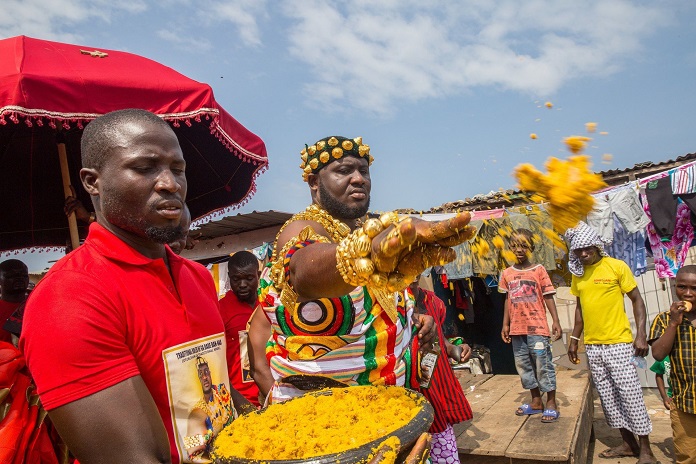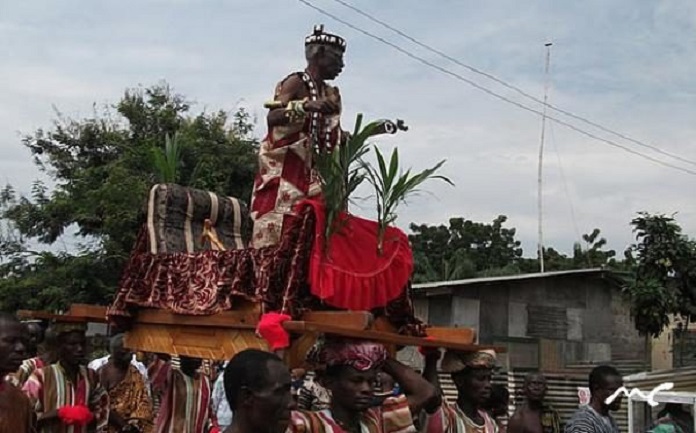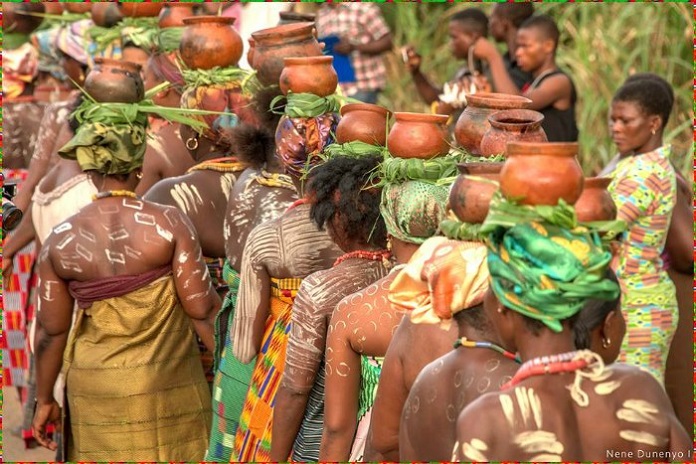Festivals are a big deal in Ghana and they attract people from all over the country as well as people from other parts of Africa and the rest of the world too. Some of these festivals have been sustained through the ages and in contemporary times. They are held every year in the West African nation, spread all year round and some of them are simply mind-blowing. Every year, millions of Ghanaians eagerly await these popular festivals and crowds pour into the streets to celebrate when the time comes.
The fact that there are so many festivals in Ghana is not quite surprising, especially because Ghanaians are known to be a very cultural set of people who understand the values of tradition and the need to uphold them. Also, Ghanaians have often been rated as a very happy set of people. Over the years, Ghana has consistently been ranked as one of the happiest countries in Africa. In fact, in 2021, it was ranked as the third happiest country in Africa. It is believed that these festivals help the Ghanian people maintain their happy nature. The festivals also serve as unifying meeting venues for Ghanaians who come out to carry out age-long cultural practices.
A Look At Some Of The Most Popular Festivals in Ghana
There are many festivals in Ghana that are celebrated every year and some of them are really massive, promoting tourism and economic development in the country.
1. Aboakyer Festival
- Date: First Saturday in May
- Tribe of Origin: Efutu people
- Meaning: “Hunting for game or animal”
- Major Activities: hunting expedition and sacrifices
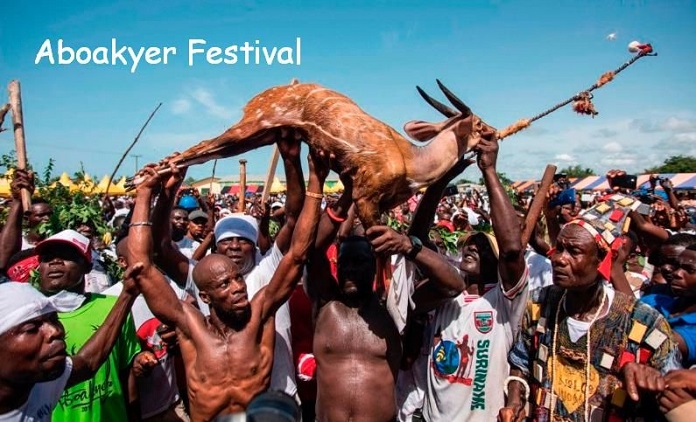
The Aboakyer festival is a bushbuck hunting festival in Ghana that catches quite a lot of attention in the country every year. The popular festival is celebrated by the people of Efutu in Winneba in the Central Region of Ghana. The festival is held every year in order to commemorate the migration of the Simpafo people. (Simpafo is the traditional name given to the people of Winneba).
The festival is celebrated on the first Saturday in the month of May every year and continues throughout the ensuing weekend. The festival is a big deal in Ghana, especially for the people in the Central Region who prepare all year for the big event. It is noteworthy that the name Aboakyer actually translates to “hunting for game or animal” in the Fante language which is the dialect that is spoken by the people of the Central Region, including the Efutu people.
Origin And Celebration Of The Aboakyer Festival
The Aboakyer festival is celebrated every year to mark the immigration of the Efutu people from their previous place of abode to where they now reside in Central Ghana. Initially, the Efutu lived in the north-eastern African town of Timbuktu in the ancient Western Sudan Empire but, after several years, they embarked on the strenuous journey from the north-east to the western part of Africa. According to legend, the journey was led by two brothers and, even though it was dangerous immigration, the people believed that a god, whom they called Otu, made sure that they were protected from all dangers during their journey.
So, after their relocation, the Efutu people decided to show their appreciation to the god, Otu for helping them resettle. To do this, they consulted a traditional priest who happened to be the custodian of the god. The priest acted as an intermediary between the people and Otu and asked the god its preferred sacrifice so that the Efutu people can offer it to him. However, to their great bewilderment, the god asked them for a human sacrifice. To make matters worse, the god demanded that the human sacrifice must be someone from the royal family. The people had no option but to begin sacrificing members of the royal family every year in appreciation of Otu.
Eventually, after engaging in human sacrifice for a long time, the Efutu people returned to Otu and asked that the sacrifice type should be changed because they were no longer interested in sacrificing humans. They explained that if they kept on sacrificing members of the royal family, the practice could end up wiping out the royal house. The god listened to them and changed the sacrifice type to a wild cat. Otu demanded that a type of wild cat must be caught alive and presented at its shrine. After the people have presented the wild cat alive, the animal would then be beheaded as a sacrifice. This was to be done annually at a festival.
Having been thus charged, the Efutu people began to seek the wild cat for the yearly festival. Every year, to mark the festival, the Efutu people would storm the bushes to find a wild cat. However, this also proved to be too dangerous because many people died in the process of finding the animal and transporting it alive to the god. Because of this, the Efutu people returned to Otu and asked the god to change the sacrifice type once again and provide an alternative to the wild cat. Once again, Otu listened to them and changed the sacrifice type to what is now used; a mature bushbuck. Otu demanded that every year, to commemorate the immigration of the Efutu people, they must present a mature bushbuck to it. They have been doing this ever since.
Today, the Aboakyer festival is highly celebrated all over Central Ghana and beyond. It also attracts people from neighboring countries. For the hunt to find the mature bushbuck, two hunting groups are charged with capturing the live bushbuck and presenting it to the people at the durbar. They are the Tuafo (Number one) and Dentsifo (Number two). The Aboakyer festival has been carefully preserved for years and is now a major event in Ghana celebrated in May every year. The popular festival is also used to receive a productive harvest, as well as some serious spiritual guidance from the gods of the Efutu people for the coming year.
2. Bakatue
- Date: First Tuesday in the month of July every year.
- Tribe of Origin: The People of Elmina
- Meaning: “Draining Of A Lagoon”
- Major Activities: Sacrifices to the river god, removal of the ban on fishing
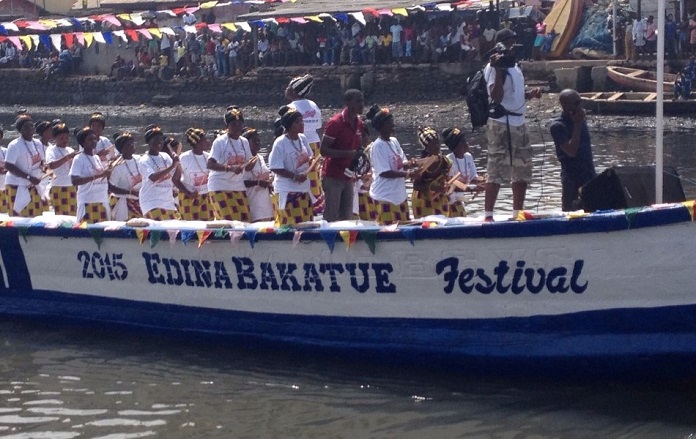
The Bakatue Festival is another popular event that is celebrated every year in Ghana. The festival is celebrated by the chiefs and people of Elmina in the Central Region of the country. The event usually turns the region into a beehive of activities and attracts people from other countries as well. The event is celebrated on the first Tuesday in the month of July every year.
For the record, the name Bakatue is a word from the Fante dialect which translates to “draining of a lagoon”. The festival is used to commemorate the beginning of the fishing season in Elmina. The grand event is also used for offering thanks and prayers to the gods of the Elmina people for a good fishing year.
Origin And Celebration Of The Bakatue Festival
The Bakatue festival is a very old event that has been in existence for ages. As a matter of fact, the festival has been in existence since the 1840s. According to reports, the Dutch reported the existence of the festival at least as far back as 1847. The festival was also mentioned in a report by the administrator of the Dutch Gold Coast, Governor Cornelis Nagtglas in 1860.
The celebration of the Bakatue festival was instituted to commemorate the founding of Elmina, the Ghanaian town which is widely known for its role in the former transatlantic slave trade, by the Portuguese in the early days of the colonization of the then Gold Coast. The people of Elmina also instituted the festival to invoke their god, Nana Benya to continue protecting the state and its people. Over the years, the relevance of the festival has been sustained and has actually become bigger with every year.
Today, to celebrate the festival, the Elmina people set aside the first Monday and Tuesday of the month of July every for the event. On Monday, all the necessary customary activities are performed by the people. However, on Tuesday, things are shaken up a little bit more. Tuesday is usually regarded as the day for the sea god so the fishermen in Elmina and in many other parts of Ghana do not go to the sea to fish. They do this in order to honor the sea god. As the seas are deserted to honor the sea god, all the people of Elmina, including the Paramount Chief, his sub-chiefs, and everyone else will offer sacrifices to Nana Brenya, the river god. The sacrifices include an offering of the sacred festival food of eggs and mashed yam mixed with palm oil. When the sacrifices are made to Nana Brenya, a prayer for peace will also be offered.
On the morning of Tuesday, the Chiefs of higher towns in Elmina will ride some decorated palanquins after all members of the Elmina royal family have participated in a royal procession made up of chiefs and stool carriers. Following this procession, the chief priest will then cast his net three times into the Brenya Lagoon as all the people watch in anticipation. When this is done, there will be declarations of the end to the ban on fishing, as well as other loud social activities like drumming and funerals in the Elmina traditional area. After this declaration, women adorned with the traditional Kente cloth and local festive headgear will ride on the lagoon and be watched by many people.
Following this, a royal procession that ultimately leads to the chief’s palace will take place amidst traditional music and great rejoicing. This is what ends the festival. At the end of the day, all fish that was caught by the net cast into the sea by the chief priest during the ceremony will be offered to the gods as a symbol to thank the revered deities for all the harvest.
3. Homowo Festival
- Date: August every year
- Tribe of Origin: The Ga people
- Meaning: “To hoot (or jeer) at hunger”
- Major Activities: Sprinkling of Kpokpoi, merrymaking, dances, singing
The Homowo festival is also one of the most anticipated festivals in Ghana. The event is a yearly harvest festival that is widely celebrated by the Ga people, an ethnic group that lives primarily in the Greater Accra region of Ghana. The Ga people celebrate the Homowo festival annually to commemorate the great famine that happened in their history and how they survived that perilous time.
The festival is a big deal and even though it is primarily an event for the Ga people, it attracts people from all over the country.
Origin And Celebration Of The Homowo Festival Festival
The Homowo festival is a very old tradition and actually dates way back to pre-colonial Ghana. The tradition began during a period of great hunger and famine due to the failure of the seasonal rains that were needed to grow crops in the Greater Accra Region, where the Ga people live. Because there were no rains, the crops failed to grow and hunger took over. The Ga people suffered this famine for an entire season and many people starved horribly in the process.
However, the hunger did not last forever as the rains returned and the crops blossomed again. The Ga people were so ecstatic that they decided to celebrate it by creating the festival and this gave birth to its name, Homowo, meaning “to hoot (or jeer) at hunger”. They have continued to hold this festival ever since and the tradition has been carefully sustained, getting bigger every year. Today, the festival is held in the month of August annually.
The pre-festival season usually kickstarts with the planting of maize, the crop that will eventually be used in preparing the food for the festival named Kpokpoi or Kpekple. It is noteworthy that during this period of planting maize, noise-making is prohibited or banned because, among the Ga people, it is believed that noise will hinder the maturity of the crop. After the maize germinates, the festival food is prepared and sprinkled within the town during the celebration. The food is also eaten with Palm Nut Soup. The sprinkling of Kpokpoi is usually done by traditional family heads and leaders. Also, all family heads of the Ga people sprinkle the “kpokpoi” in their family house.
For the celebration proper, the Ga people in large numbers march down the roads and streets singing traditional songs, dancing to the songs, beating drums, merrymaking face painting, chanting, and more. The celebration is so huge that it often causes lots of traffic in Accra because roads are often blocked off in order to accommodate the celebrants.
4. Kundum Festival
- Date: August
- Tribe of Origin: Ahanta and Nzema people
- Meaning: ‘Famine Could Not overpower Us’
- Major Activities: Dancing, drumming, feast
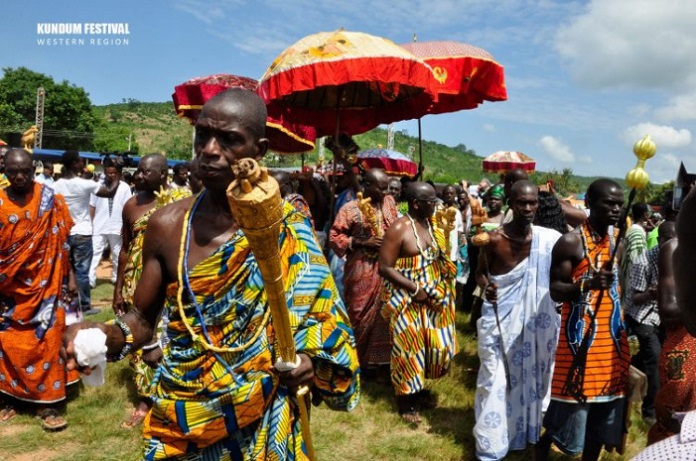
The Kundum festival is celebrated by the Ahanta and Nzema people of the Western region of Ghana yearly. The unique thing about this festival is that it is celebrated across four weeks in August. The event is celebrated at weekly intervals from town to town during the one-month period. The Ahanta and Nzema people hold the Kundum festival to thank God for the abundance of food at the time of the harvest period of the area.
Origin And Celebration Of The Kundum Festival
The Kundum festival is also a very old tradition in Ghana. The exact time it started is not entirely certain but one of the earliest written records of the event was documented by Bosman, a Dutch explorer who observed the festival after he traveled to the Gold Coast in the 17th century. Legend has it that the tradition began after Akpoley, a hunter, stumbled on some dwarves who were dancing in a circle, during an expedition. Akpoley observed the dance for a while and returned to his town where he introduced it to his people. The dance became known as a ritual dance used for expelling evil spirits and the devil from towns and villages. The dance is now performed during the festival by the people.
Today, the Kundum festival is celebrated as both a harvest and religious festival and is celebrated across four weeks. In the first three weeks, festive activities like drumming and dancing are kept at a minimum and take place only at night. In fact, the drummers spend these 3 weeks on the outskirts of the town, practicing and preparing for the fourth week. On the Monday of the 4th week, the ritual Kundum fire is built at the chief’s palace and is ultimately kept burning bright throughout the festivities. The next day, on Tuesday, sacrifices of fowl or sheep are offered in a sacred palace where the stools of departed chiefs and elders are kept. The room is called the stool room.
Finally, a fowl gets sacrificed publicly in the courtyard. Afterward, lots of singing begin on Tuesday and Wednesday and the chief will join the festivities. The remainder of the fourth week is spent by the people performing the ritual of Kundum dancing. Interestingly, the Kundum festival is more than just a time for dancing and merriment. The festival is also a time for the Ahanta and Nzema people and their chiefs to sit down and resolve conflicts. They also engage in planning developmental projects for the town and welcoming back the natives who had traveled to other places.
5. Fiok Festival
- Date: December every year
- Tribe of Origin: The peoples of Sandema
- Meaning: ‘Abundance of food‘
- Major Activities: Thanksgiving for harvest, a re-enactment of ancient heroic exploits
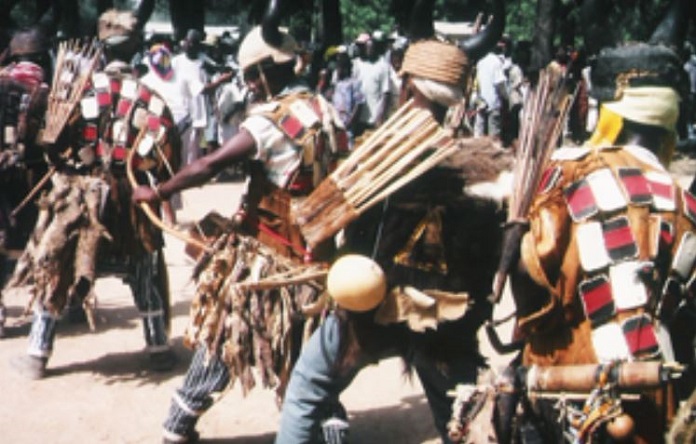
Also widely anticipated, the Fiok festival is a Ghanaian festival that is celebrated by the Bulisa people of Sandema in the Upper East Region of the country. The event is actually a thanksgiving and war festival that the Bulisa people use to remember the heroics of their warriors from ancient times and also thank their gods for a great harvest. The popular festival is now celebrated every year in the month of December.
The Origin And Celebration Of The Fiok Festival
The Bulisa have always been a thankful set of people. They understand the essence of praying to their gods for the protection they have always gotten. This is what led to the rise of the Fiok festival. The event celebrates the help the Bulisa people have had from the gods to defeat their enemies in times of war and also to thank them for great harvests and food.
For a long time, the festival existed as a traditional harvest thanksgiving sacrifice that was practiced in almost all traditional homes. However, in the year 1974, it became more of a district or national festive occasion. Today, it is a widely practiced tradition in Ghana. During the festival, war dancers storm the streets from different villages in the region to perform on stage. These dancers are often armed to the teeth with short axes, bows and arrows, shields, and spears to display the image of African warriors.
The dancers are heavily armed with these weapons to relive scenes from wars that were fought by Bulisa warriors in previous years. Also, the dancers are known to re-enact scenes of resistance during the festival. Sacrifices are also made to the gods to thank them for a bountiful harvest during the year. In contemporary times, the Fiok festival has become very significant among the Builsa.
6. Fetu Afahye
- Date: First Saturday in September
- Tribe of Origin: The Oguaa people of Cape Coast in Central Ghana.
- Meaning: ‘Doing away with dirt’
- Major Activities: Ritual functions, sacrifices
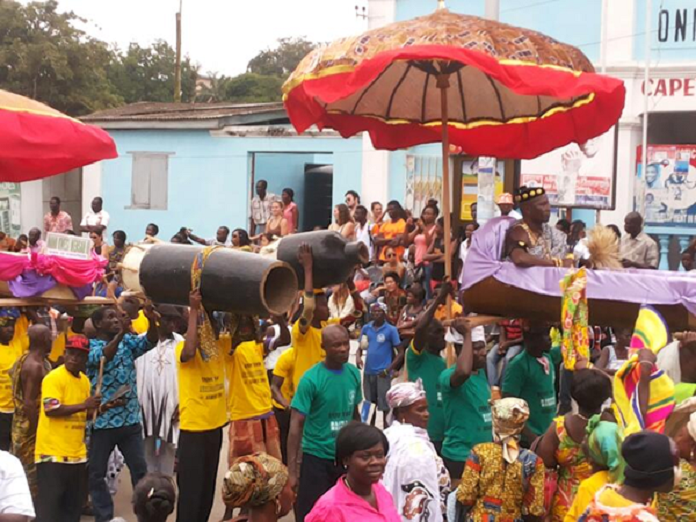
The Fetu Afahye is one of the most anticipated festivals in Ghana. The event, which is celebrated by the Oguaa people of Cape Coast, is very significant to them. The festival is held to commemorate the outbreak of a terrible disease that devastated people centuries ago.
Origin And Celebration Of The Fetu Afahye Festival
The origin of Fetu Afahye goes way back to pre-colonial Ghana when the Oguaa people of Cape Coast were struck with a horrific disease. The plague was so devastating that it killed so many people and posed a serious threat of annihilation. Seeing how terrible the plague was, the people cried out for intervention from their gods. The gods answered and they were saved. After their salvation, they decided to celebrate a festival every year to commemorate that horrific time and also pray to the gods to avert any such occurrence in the future. This led to the Fetu Afahye festival.
It is noteworthy that during the colonial period, the colonial masters stopped the festival for a while but it was eventually resumed between 1948 and 1996 after the paramount chief at the time debunked this conception. Today, the festival is a big deal in Ghana and takes place in September every year. Shortly before the festival starts every year, all festive activities like drumming are banned. Fishing is also banned. This is done to allow the spirits of Oguaa to take over the process of planning the festival.
During the festival proper, different rituals are carried out. The custodians of the Fosu Lagoon pour libation at the estuary of the lagoon and call on the spirits of their ancestors to wipe out any bad omen from the people and also call for a bumper harvest. The people are also made to observe “Amuntumadeze” meaning “health day” when everyone in the communities will actively clean the environment, as well paint all buildings and clear waste. Livestock is also slaughtered and sacrificed to the 77 deities in the area in appreciation to them. This is followed by heavy dancing and merriment by people adorned in beautiful clothes.
7. Asafotufiam Festival
- Date: First week of August every year
- Tribe of Origin: The peoples of Ada in the Dangbe East of the Greater Accra
- Meaning: “Divisional Firing of Musketry”
- Major Activities: Firing of musketry, dancing, pouring of libation
The Asafotufiam Festival is a very popular event that is celebrated every year by the people of Ada in the Dangbe East area of the Greater Accra region of Ghana. Asafotufiam is a war festival that commemorates the wartime heroics of the Ada people from years past. It has become one of the significant events among the Ada people and is celebrated in the first week of August every year.
Origin And Celebration Of The Asafotufiam Festival
The origin of the Asafotufiam Festival dates back to some centuries ago. According to legend, the Ada peoples used to fight a lot of wars in a bid to establish a territory for their people. These wars were very tough but the Ada people were able to withstand all the attacks against them and survived all the wars, ultimately leading to the establishment and growth of the Ada Kingdom. At the height of the wars, the Ada people who were very proud of their soldiers often put together rituals to welcome brave soldiers and war heroes back home from the battles.
After some time, in the 1900s, there were no more wars to be fought so the rituals of welcoming soldiers were phased out because they were no longer needed. But, years later, the people decided that they still had to honor their brave soldiers, their ancestors, and past chiefs who all fought and greatly contributed to the successful establishment of Ada Kingdom. This is what led to the creation of the Asafotufiam Festival. The festival has been held ever since to commemorate the heroics of the great soldiers and warriors of the Ada people.
Today, the festival is held every August. The big celebration begins on Thursday in the first week of August. On that day, sons and daughters of the Ada people who had traveled would return home to a great welcome. That day is also devoted to a house-cleaning ceremony and pouring of libation. The next day, all young men who had attained puberty age are famously initiated into their respective war groups known as Asafo companies. They are taught how to handle, load a gun and fire the weapon. This is followed by a mock battle performance with elegant costumes. Singing and dancing will take place amid processions with chiefs in palanquins.
8. Fao Festival
- Date: January every year
- Tribe of Origin: The peoples of Navrongo in the Upper East Region of Ghana.
- Major Activities: Display of harvest

The Fao Festival is an annual event celebrated by the people of Navrongo, who live in the Upper East Region of Ghana. The festival is celebrated every year in the month of January and is held in high esteem by the Navrongo people. The event is usually held to give thanks to the gods for giving them a great harvest.
Origin And Celebration Of The Fao Festival
The people of Navrongo, made up mainly of Kassenas and Nanknanis tribes have always been people who adore culture, tradition, and adherence to religious practices, including the worship of the gods. According to legend, the ancestors of the Navrongo people never lacked a bountiful harvest as the rains came in abundance at the right time and the crops grew. They decided to come together to create a ritual that would show the gods their appreciation and also pray for their continual support in giving them a great harvest. This is what led to the creation of the Fao festival.
The festival has been celebrated every year ever since. The event is held in January to commemorate the end of the harvest season and also to thank their gods and ancestors for the provision of adequate rains throughout the season of cropping. When the festival starts, the Kassena and Nankani peoples of Navrongo bring out their first harvest of millet and display the stalks as a sign of sacrifice, and thankfulness to the gods. This is followed by a procession of chiefs dressed in traditional attire, as well as dancing and merriment. Prayer is also offered to the gods for more rains and better harvests in the coming years.
9. Ngmayem Festival
- Date: October every year
- Tribe of Origin: The peoples of Manya Krobo in the Eastern Region of Ghana.
- Meaning: Eating the New Millet
- Major Activities: Cleansing ceremonies, thanksgiving services, visitation of royal tombs

The Ngmayem annual festival is one of the popular festivals in Ghana. The event is held every year in the month of October by the chiefs and peoples of Manya Krobo who live in the Eastern Region of Ghana. The festival has grown in importance over the years and is now one of the most important yearly rituals of the Manya Krobo people.
Origin And Celebration of The Ngmayem Festival
The Ngmayem festival was established in 1944 by Nene Azzu Mate Kole II, the king of the Manya Krobo Traditional Area at the time. Before that time, there was another festival already in place which the people celebrated every year. That festival was called “Yeliyem”, which literary means ‘eating of yam’. However, Nene Azzu Mate Kole II changed it to the Ngmayem festival in 1944 with the new name Ngmayem – meaning “Eating the new millet”.
According to some reports, the Ngmayem festival was established to commemorate the end of a famine that occurred some hundreds of years ago among the Manya Krobo people, and also to celebrate the historic importance of ngma, or millet, to the survival of the tribe through the centuries. The festival has grown to become a very important event for the people and now serves as a period when they can give thanks to their creator for life, plentiful harvest, and protection.
In contemporary times, the popular festival is usually celebrated for one whole week, mostly starting from the last two Sundays of the month of October. Many activities are planned and carried out during the festival, including cleansing ceremonies, thanksgiving services, the commemoration of ancestors, as well as visitation to royal tombs. There is also a lot of dancing and merriment and lots of colorful outlooks. This is because festival-goers at the Ngmayem event are known to dress up in colorful attire and adorn themselves with beads.
Importantly, during the festival, the leaders of the people often conduct a court reception (or durbar), during which tribe members meet with chiefs to sit and talk about the government and hear updates on development projects and political issues affecting the people.
10. Hogbetsotso Festival
- Date: First Saturday in November
- Tribe of Origin: The people of Anlo in the Volta Region of Ghana
- Meaning: “Festival of the exodus”
- Major Activities: Traditional dances, peace-making
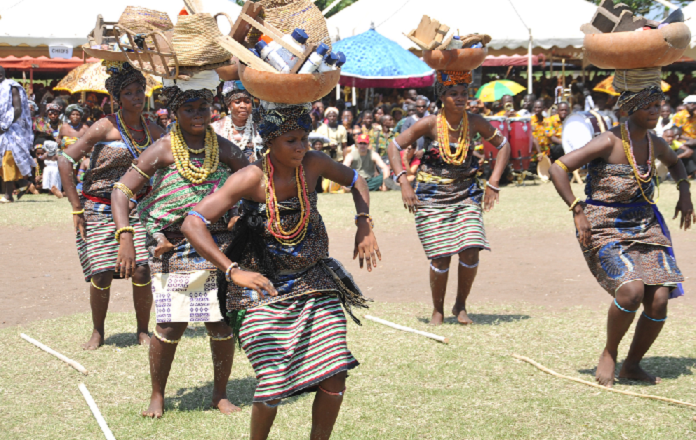
The Hogbetsotso festival is an annual event that is celebrated by the Anlo people who live in the Volta region of Ghana. The festival is very popular and has been attended by very popular and important figures in the past, including ex-presidents, John Dramani Mahama, and Jerry John Rawlings. It is among the most anticipated traditional events in Ghana.
Origin And Celebration Of The Hogbetsotso Festival
Unlike the other festivals that date back to hundreds of years ago, the Hogbetsotso festival is relatively new. In fact, the festival was established only about four decades ago but the story behind its establishment goes way back to centuries ago in pre-colonial Ghana. According to legend, the Anlo people who now live in the Volta Region of Ghana used to live in a town called Notsie, which is located in present-day Togo. It is also believed that before they settled in Notsie, they used to live in southern Sudan.
While in Notsie, the Anlo people lived under a very wicked king called Togbe Agorkoli. The king made sure they suffered terribly and they decided to escape from his tyranny. In order to successfully run away, they came up with the idea to create a hole in the mud wall that surrounded their town so that they can escape through it. To achieve this, they asked their woman to constantly pour all their wastewater on one particular place in the wall. The women did this for years and, eventually, that particular spot became very soft and this allowed the Anlo people to break through it and escaped. While they were escaping, the people cleverly decided to walk backward with their faces towards Notsie such that their footprints appeared to be walking into the town. They did this to avoid pursuit and it worked. The Hogbetsotso festival is held to commemorate this escape of the Anlo people which is why the name Hogbetsotso means “the festival of exodus” or “coming from Hogbe (Notsie)”
The festival is a big deal among the Anlo people and different ceremonies are carried out during the annual event. Some of these events include a purification ceremony of the ceremonial stools through the pouring of libations, as well as a general cleaning where all the villages are swept and rubbish burnt. Another important part of the festival is a period of peace-making. During this period, all disputes and quarrels are quashed with the finding of an amicable solution between warring parties. The festival climaxes with a durbar of the chiefs and people of Anlo where the chiefs are dressed in colorful regalia/ kente and receive homage from their subjects at the durbar grounds. There is also a lot of dancing and merry-making.
11. Ohum Festival
- Date: September or October every year
- Tribe of Origin: The Akuapem and Akyem peoples
- Major Activities: Offering of thanks to the gods, dancing

The Ohum Festival is a popular traditional festival that is celebrated by Akuapem and Akyem peoples who live in the Eastern Region of Ghana. The event is very famous in Ghana and is the most important cultural event for the Akuapems and Akyems. The event is held on Tuesdays and Wednesdays in September or October every year.
Origin And Celebration Of the Ohum Festival
The Akuapems and Akyems have lived in peace for centuries. In a bid to establish and safeguard their territories, the ancient Akuapems and Akyems fought wars and eventually triumphed. Also, they witnessed a lot of prosperity and bumper harvests in their history. For this reason, they came together to establish a ritual that will let them thank the gods and ask for help in gaining more bountiful harvests and peace. Thus, the Ohum festival was born and has been celebrated for ages.
Today, the festival is held in September or October every year. Before the celebration properly starts, a two-week ban on noise-making is imposed on the community and no one would be allowed to make loud sounds. For the festival proper, the farmers and fishermen among the Akuapems and Akyems show up carrying products and harvests from their lands and the river to honor the gods. They offer thanks to their creator for the gift of the Birim river and for the bountiful harvests.
Other ceremonies are carried out during the festival, including the cleansing of stools and remembrance of the ancestors of the people for their struggle to keep the kingdom alive. This is followed by prayers for more harvests and peace in the coming years. It is noteworthy that during the festival, the people are also made to make pledges to continue keeping the tradition alive and to keep their kingdom strong. They also pledge allegiance to their king and his sub-chiefs and elders.
12. Bugum Chugu (Fire Festival)
- Date: First month of the Dagomba lunar year
- Tribe of Origin: Dagomba people
- Meaning: ‘Lost of a chief son’
- Major Activities: Lighting of fires, dancing

The Bugum Chugu festival, also known as the fire festival is an annual event that is celebrated by the Dagomba people who live in the Northern Region of Ghana. The festival is a very popular one in Ghana and attracts many people from all over the country to witness it. The festival is celebrated every year to remember the period when the son of a Dagomba king went missing.
Origin And Celebration Of The Bugum Chugu Festival
The origin of the Bugum Chugu festival is a very interesting one. According to legend, the fire festival goes way back to a period in the history of the Dagomba people when their king lost his son. The king’s son had gone out to play with his friends when he went missing. As per oral history, as he was playing, the king’s son suddenly felt tired and went to rest under a tree. While resting he fell asleep, unknown to his friends. When his friends finished playing, they forgot about him and went home. Soon, the king and his queen realized their son was missing so the king gave an order to all his subjects to go out and search around the neighborhood for the prince. But, despite their search, they could not find the boy and the king became frantic. He assembled the warriors of the kingdom and charged them to find his son. Since it was dark, the warriors lit torches and dashed into the bush where they eventually found the prince lying under the tree fast asleep.
When the king heard that his son was found under a tree, he thought that the tree stole the prince and hid him at its roots. Because of this, the king declared that tree an evil tree and threw the lit torch that he was holding on it. Afterward, the king ordered that the scary event should be marked yearly to commemorate the event. This is how the Bugum Chugu festival was born. The festival has been celebrated ever since and has grown bigger every year. Today, it is one of the most celebrated events among the Dagomba people.
Today, the festival is celebrated on the ninth day of the first month of the Dagomba lunar year. The main event starts after the evening meal when the drum beater storms the king’s palace to sound the drum. Through his drumming, the Elders of the state are summoned to the palace to meet the king. The elders will arrive one after the other followed by the commoners who all come with lit torches in their hands. After everyone has assembled outside the palace with their burning torches, the king will be summoned from within by the elders. When he emerges, he will lead the way to a little distance ahead of the crowd and throw his torch. This kickstarts the festival and everyone will go into a frenzy. After the king goes into his palace, there will be a lot of yelling and chanting in a war-like manner by the people who are accompanied by loud-sounding drums. Even today, the people still dress as warriors when celebrating Bugum Chugu.
13. Apoo Festival
- Date: March and April
- Tribe of Origin: The Bono people
- Major Activities: Dancing, purifying rituals
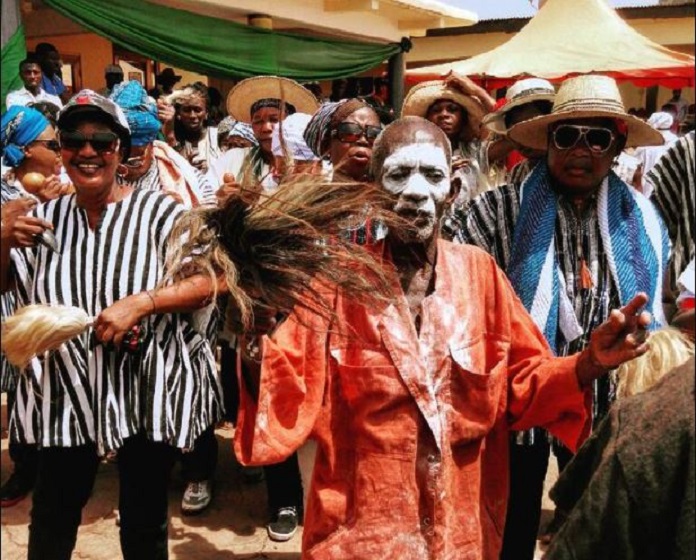
The Apoo Festival is a popular event that is celebrated annually in March and April by the Bono people in the western part of Ghana (specifically the towns of Techiman and Wenchi). The festival has become a very popular affair in Western Ghana and holds a lot of significance for the people there. The widely celebrated festival is held by the Bono people to ritually purify their people of all the social evils plaguing them and also unite people and families.
Origin And Celebration Of Apoo Festival
According to oral tradition, the Apoo festival began a long time ago under the reign of the ruler, Nana Kwakye Ameyaw. Legend has it that the king was an authoritarian leader and was so autocratic that the people of Techniman could not freely express their views about how the affairs of the kingdom were being run or complain about the king and his council of elders. Because they could not speak truth to power, the people decided to complain to the gods and the gods commanded them to pick a day that they would set aside to express their sentiments towards the king and the authorities. It was agreed then that no one could be held responsible for what he or she said about the authorities regardless of status and this was how the “Apoo” festival was born.
Today, the festival is highly anticipated because it is the time to bury the hatchet, speak up about the evil someone has done to you and then forgive and move on. This is because it is believed that when people air their grievances and grudges, their souls are ritually purified of evil. Before the festival starts, women usually engage in cleaning homes, roads, and utensils to avoid evil spirits from returning. Also, priests of the Bono people will parade the streets before the festival to spiritually destroy malicious charms hidden by evil spirits. Importantly, white clay is also collected by the women from the famous Aponkosu River and is used to decorate the local shrines.
When the festival starts properly, drums get beaten to alert people of the process. First, the Paramount Chief of the people, as well as village elders and secondary chiefs, will lead a procession during which people will air their grievances and expose the wrongdoings of others in order to settle their quarrels. People are encouraged to settle scores and set aside family feuds during this time because it is a time for reconciliation. In fact, even the king is not left out of being chided by those he has wronged on that day. Nobody is above being scolded that day. But it is mandatory to forgive after one has aired their grievances.
Another important activity during the festival is the offering of sheep as sacrifice and the pouring of libation on the grave of the last Bonohene, the traditional leader of the Bono people. The Chief also summons the ancestral spirits for prosperity and peace. After this, what follows are days filled with lots of festivities. Usually, families spend lots of money on food during this period as they host visitors and treat them well. No one is allowed to hurt anyone at this time. There is also singing dancing and a fine parade of elderly women on the streets singing traditional Apoo songs. The festival is also known for its flamboyant and unusual outfits because men and women taking part in it usually dress up in all manner of trendy clothes.
14. Opemso Festival
- Date: Once every two years
- Tribe of Origin: The Ashanti people
- Major Activities: Special rituals, offerings, dancing, drumming
The Opemso Festival is a bi-annual festival that is very popular among the Ashanti people of Ghana. The festival is held every two years in Ghana in order to commemorate the iconic birth of Otumfuo Osei Tutu I, the first king of the Ashantis. Over the years, the festival has become very important and significant to the Ashanti people.
Origin And Celebration Of Opemso Festival
The Opemso festival was instituted to celebrate the unique events that led to the birth of Otumfuo Osei Tutu I, the very first king of the Ashanti people, who united the seven Akan clans to form the Asante Kingdom. According to legend, before Otumfuo Osei Tutu I was born, his mother, Nana Gyamfua Manu Kutusi, desperately tried to have children but failed due to several miscarriages she had. Eventually, she reached out to a traditional priest who spiritually helped her to conceive a male child. When it was time to deliver, Osei Tutu’s mother decided to travel to his grandmother’s hometown at Esiase in the Ashanti Region to have him.
However, problems arose when the birth pangs increased while she was still on her way. Desperate for help, she sought spiritual help from the Kaakawere River at Kokofu-Anyinam and promised the river of a fowl as well as a bottle of schnapps if her son is born safely. The river deity took pity on the woman and redirected three hunters to come to assist her by taking her to the queen-mother of Kokofu-Anyinam who in turn took her to a safe spot under a big Ceiba or Onyina tree to have her baby. That tree is now called Onyina Sei. These are the events that are now celebrated at the Opemso festival.
Today the festival is very important to the Ashanti people because it signified the birth of the man who gave the people freedom from their enemies. During the festival, thousands of Ashanti people and their leaders led by the Asantehene will walk through the street to the sacred grove where Otumfuo Osei Tutu I was born. They will offer offerings of fowls and schnapps and make special rituals to the Kaakawere river. The events leading to the birth of their first king is also dramatized with some people playing the role of the king’s mother and others playing the role of the three hunters and so on. Also, a beauty pageant known as Miss Opemso is held as part of the festival. There is also a lot of dancing, singing drumming, and other forms of merriment.
15. Dzawuwu Festival
- Date: February every year
- Tribe of Origin: The Agave people of the Volta Region of Ghana
- Meaning: Sprinkling Of Food
- Major Activities: Sprinkling of food to the gods, libations
The Dzawuwu Festival is an annual event that is celebrated by the Agave who live in Dabala in the Volta Region of Ghana. The popular event which is actually a thanksgiving festival is celebrated by chiefs and people of Agave every year to thank the gods for the survival of their tribe through the centuries.
Origin And Celebration Of Dzawuwu Festival
The Agave people have always been known to be fearless warriors. Their history is filled with tales of heroic exploits by mighty soldiers who went all out to ensure that the unity of their kingdom is held together. The Agaves fought so many wars with neighboring kingdoms and clans in the heated quest to foil plans by other people to take them captive. In the end, the battles paid off and they remained one, united Agave kingdom. By way of oral history, the younger generation of the Agave people have been told of the heroic exploits of their ancestors and the festival is a way of celebrating their heroism in times past.
Today, the festival is usually celebrated in the month of February and is a special time for the Agaves. During the Dzawuwu festival, the Agave people take time to pay homage to those who have departed and people who worked to keep the tribe together and away from captivity. The people also come out with traditional priests who sprinkle special portions of food to the gods of the people to give thanks for their protection and also ask for more protection. The Agaves believe that their tribe only survived because the gods showed support to the warriors who fought their battles in ancient times hence the need to especially thank them during the festival. Also, libations are poured in special rituals and the people are made to renew their loyalty to their rulers.

